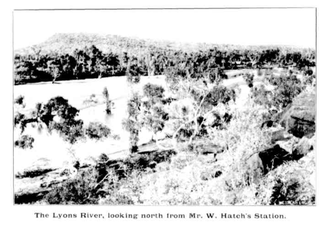Country
According to Norman Tindale's estimation the Wariangga's tribal lands stretched over approximately 1,700 square miles (4,400 km2) in the Gascoyne region, covering areas of the Upper Lyons River, and including also Gifford and Minnie creeks, Edmund and the area east of Maroonah. Tindale states also that they held to a strict maintenance of boundaries. Their neighbours were the Tenma to the north, the Dyiwali to their northeast, the Ninanu directly east, the Watjarri southeast, the Malgaru at their southern limits, and the Tharrkari due west.

Norman Barnett Tindale AO was an Australian anthropologist, archaeologist, entomologist and ethnologist.

The Gascoyne region is one of the nine administrative regions of Western Australia. It is located in the north west of Western Australia, and consists of the local government areas of Carnarvon, Exmouth, Shark Bay and Upper Gascoyne. The Gascoyne has about 600 km (370 mi) of Indian Ocean coastline; extends inland about 500 km (310 mi); and has an area of 138,000 km2 (53,000 sq mi), including islands.

The Lyons River is a river in the Gascoyne region of Western Australia.
This page is based on this
Wikipedia article Text is available under the
CC BY-SA 4.0 license; additional terms may apply.
Images, videos and audio are available under their respective licenses.
The Wardandi are an indigenous Noongar people of Western Australia.

Wiilman are an indigenous Noongar people from the Wheatbelt, Great Southern and South West regions of Western Australia. Variant spellings of the name include Wilman, Wilmen and Wheelman. Wiilman is the endonym.
The Bibulman (Pibelmen) were an indigenous Australian people of the southwestern region of Western Australia
The Mandi, otherwise known as Manthi, were an indigenous Australian people of Western Australia.
The Tharrkari, also referred to as the Targari, are an indigenous Australian tribe of Western Australia.
The Jadira are a people and territory mentioned by Norman Tindale in his classic ethnographic map of Australian tribes. The status of Jadira in the sense defined by Tindale has been recently questioned by Paul Burke.
The Waljen are an indigenous people of Western Australia, in the Goldfields-Esperance area.
The Maduwongga are an indigenous Australian people of Western Australia.
The Ngurlu, also known as the Ngulutjara, are an indigenous Australian people of Western Australia.
The Panyjima are an indigenous people of the Pilbara region of Western Australia.
The Mandara were an indigenous Australian people of the Pilbara region of Western Australia. They are extinct, having been absorbed into neighboring peoples, and their language is unrecorded.
The Warrwa are an indigenous Australian people of Western Australia.
The Malgaru were an indigenous Australian people of Western Australia. They might have been a subgroup of the Wariangga.
The Ninanu were an indigenous Australian people of the Gascoyne region of Western Australia.
The Djiwarli are an indigenous Australian people of Western Australia.
The Widi were an indigenous Australian people of Western Australia.
The Binigura were an indigenous Australian people of the Pilbara region of Western Australia.
The Ngombal, also known as the Ngumbarl, are an indigenous Australian people of Western Australia.
The Nyulnyul are an indigenous Australian people of Western Australia.
The Inawongga were an indigenous Australian people of the Pilbara region of Western Australia.





